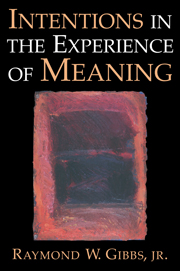Book contents
Chapter 7 - WRITING AND READING
Published online by Cambridge University Press: 05 June 2012
Summary
Most people aren't terribly surprised to learn that speakers' intentions are critical to listeners' understanding of spoken language. After all, the close physical proximity between speaker and addressee – the person to whom the speaker directs his or her utterance – forces people to seek out a speaker's communicative intentions. Much of the evidence discussed in the previous chapters lends credence to the idea that speakers' intentions are essential to spoken language interpretation. But does this conclusion hold true for how people interpret written language?
Understanding written language presumably differs from comprehension of verbal speech, because written language tends to be more “decontextualized,” with far fewer cues available about an author's possible communicative intentions. Writers, unlike speakers, do not produce language in the company of someone else who is the intended audience for what is written. For this reason, a written text, unlike spoken communication, must function apart from the context of its production. Philosophers back up this assertion by having us consider situations like the following. Imagine that you are blindfolded and brought into a room in which sits a table.
- Type
- Chapter
- Information
- Intentions in the Experience of Meaning , pp. 176 - 202Publisher: Cambridge University PressPrint publication year: 1999



